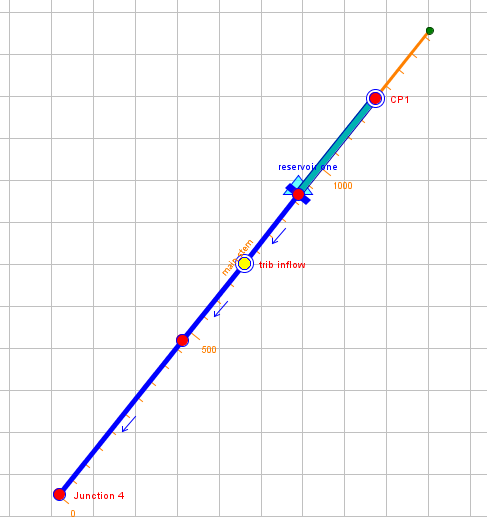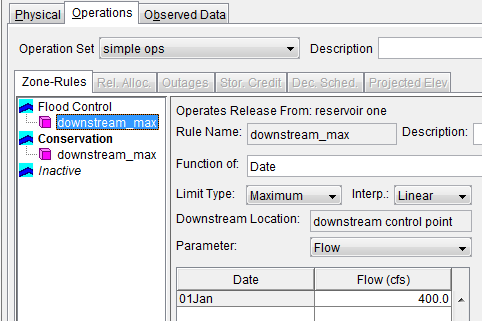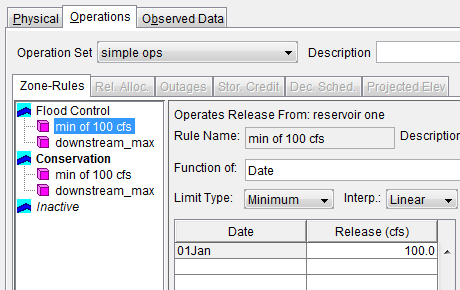This example will demonstrate the use of the downstream control function. This model contains a single stream with one reservoir. At the upstream end of the model, there is 500 cfs entering. At the junction named "trib inflow", there is also 500 cfs entering. "Trib inflow" is highlighted in yellow in the figure below.
In the first simulation, the maximum flow at the downstream control point is set to 400 cfs.
The plot below shows the flow at the downstream control point. After the lookback period ends, the flow at that point is 500 cfs. Initially, it may seem that the rule is being violated since the flow exceeds 400 cfs. However, ResSim is unable to control flow in the uncontrolled areas. Recall that 500 cfs is coming into the system below the reservoir.
In the next example, I set the downstream control point maximum to 800 cfs.
The outflow is then set to 300 cfs since we have 500 cfs coming in downstream. The pool still rises since inflow exceeds outflow, but not as high as we saw in the first example. Note that I am using null routing in these examples for simplicity.
The downstream control point is highlighted in the figure below. Notice that it is below the point "trib inflow". For the three simulations that I will be showing, the pool begins in the flood pool meaning that ResSim will want to release as much as possible. To illustrate the use of the downstream control function, a maximum flow is set at the downstream control point.
In the first simulation, the maximum flow at the downstream control point is set to 400 cfs.
The plot below shows the flow at the downstream control point. After the lookback period ends, the flow at that point is 500 cfs. Initially, it may seem that the rule is being violated since the flow exceeds 400 cfs. However, ResSim is unable to control flow in the uncontrolled areas. Recall that 500 cfs is coming into the system below the reservoir.
Once we look at the reservoir plot, we can see the ResSim is behaving properly. In the upper plot, we can see that the pool is rising (green line in upper plot) since we have 500 cfs of inflow and zero outflow (green line in lower plot). The outflow is set to zero since we are already violating the downstream control point limits.
In the next example, I set the downstream control point maximum to 800 cfs.
The outflow is then set to 300 cfs since we have 500 cfs coming in downstream. The pool still rises since inflow exceeds outflow, but not as high as we saw in the first example. Note that I am using null routing in these examples for simplicity.
After the lookback period, we can see that the flow at the downstream location is held at 800 cfs. Also note that the local flow is shown by the line with the triangle symbols.
The final simulation will use the downstream control function rule from the first example (400 cfs maximum) along with a minimum release rule of 100 cfs. The minimum release rule is set to a higher priority based on its location in the rule set. As we saw in the first simulation, the downstream maximum flow of 400 cfs was being violated due to the tributary inflow. ResSim set the reservoir release to zero because of this. However, with a minimum release of 100 cfs added to the rule set, the downstream maximum is further violated.
Rule set with minimum release at higher priority than maximum downstream control function.
ResSim recognizes that the 400 cfs downstream limit is being violated; however, the minimum release is a higher priority so that release is made (green line in lower plot).
Flow at downstream location consists of the 500 cfs of tributary inflow along with the 100 cfs from the reservoir to give a total of 600 cfs.











Hey! Is there any way to make the model work in a different way? For example setting that the highest priority of your system is to satisfy a downstream demand (diversion) rather than store water in the reservoir and follow the guide curve.
ReplyDeleteHi Kevin, I have a similar question as the user above. My model contains 4 upstream reservoirs which together operate for seasonal storage, which they release in late summer so that water can be re-diverted downstream. When the diversion season starts, I have my GCs set to lower so the reservoirs begin draw-down, and then I limit their releases using a downstream control rule. If the upstream reservoirs draw down too quickly, the diversion dam will spill and the water will be lost.
ReplyDeleteI am encountering unstable behavior where the upstream reservoirs obey the downstream control rule (limit max flow at downstream diversion dam) on some time-steps but not others, seemingly at random. The downstream control rule is high priority and physically possible, but seems to be ignored sometimes. I am baffled by this. When reviewing decision reports, I see that the downstream control rule is the active rue for a reservoir during the same time-step that it is releasing too quickly.
Do you know why a reservoir would ignore its highest priority rule even when it is physically possible to release water more slowly? It seems the desire to reach the GC is overruling even my highest priority rules. Any ideas for how how to trouble shoot this issue are greatly appreciated. Your blog is an amazing resource and I'm grateful for your hard work. Thank you!
Frank,
DeleteTwo issues come to mind. The first would be an uncontrolled outlet since those are not affected by the rules. The next issue would be the pool rising to the top of a zone where the rule doesn't apply. If neither of those are occurring, there could be an issue with the rule. You mention 4 upstream reservoirs. Typically, rules are unique to a specific reservoir, but the same downstream control function rule needs to be used at all reservoirs so you want to create the rule at one reservoir and then use that existing rule at the others. I am not sure if the 4 reservoirs are in parallel or series or a combination. If they are in series, I would recommend trying the downstream rule only at the one that is nearest the downstream control point and look at that behavior. If they are in parallel, you want to make sure that the same rule is being used at all of the reservoirs. Let me know if that helps and if you figure out the solution. I have had issues with trying to get the downstream control rules to work well when the reservoirs are in series especially if you have other rules governing their operations so I try to simplify the logic for ResSim and look at the behavior and then try to build in the other rules to see if I still like the results.